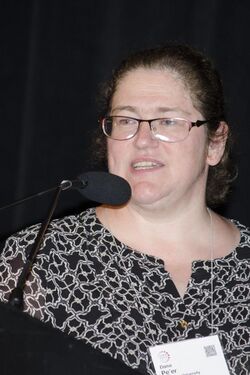Biography:Dana Pe'er
Dana Pe'er | |
|---|---|
 Dana Pe'er speaking at ISMB 2014. | |
| Born | 1971 (age 52–53)[1] |
| Alma mater | Hebrew University of Jerusalem[2] |
| Spouse(s) | Itsik Pe'er[3] |
| Children | Inbar, Carmel[4][5] |
| Awards |
|
| Scientific career | |
| Fields | Biology Computational biology Systems biology |
| Institutions | Harvard Medical School Columbia University |
| Thesis | From Gene Expression to Molecular Pathways (2003) |
| Doctoral advisor | Nir Friedman |
| Other academic advisors | George M. Church |
Dana Pe'er is currently the Chair and Professor in Computational and Systems Biology Program at Sloan Kettering Institute and regarded as one of the leading researchers in computational systems biology.[3][7] Previously, she was a professor at Columbia Department of Biological Sciences. Pe'er's research focuses on understanding the organization, function and evolution of molecular networks, particularly how genetic variations alter the regulatory network and how these genetic variations can cause cancer.[8][9][10][11][12][13]
Education
Pe'er received her bachelor's degree in mathematics in 1995, her master's degree in 1999 and her PhD in computer science in 2003, all from the Hebrew University of Jerusalem. Her PhD work used machine learning and Bayesian networks to automatically infer regulatory relations between genes, using genomics data. Her PhD advisor was Nir Friedman.[7][14][15]
She was subsequently a postdoctoral research fellow in the lab of George M. Church[16] in the Department of Genetics at Harvard Medical School, focusing on how genetic variation changes the regulatory network between individuals and how this subsequently manifests in phenotypic diversity.[7][14]
Research
Pe'er's lab at Columbia University continues her previous research; firstly, developing computational methods to combine diverse sources of high throughput genomics data and secondly, to develop a holistic view of the cell at a systems level.[17]
One particular focus is on developing methods to determine how genetic variation in DNA alters the regulation of gene expression, with a view to applying this knowledge in personalized cancer treatment. For instance, the ability to predict how particular drugs (individually or in combination) will react with tumours would allow drugs to be prescribed on a per-patient basis.[7][8]
Awards and Honours
Pe’er currently serves on the editorial board of the journal Cell.[18]
Pe'er has won several prestigious awards including a Burroughs Wellcome Fund Career Award, a NSF CAREER award and a Stand Up To Cancer Innovative Research Grant. She was awarded an NIH Director's New Innovator Award in 2007 in order to investigate how genetic variations can cause changes throughout the whole body which can lead to autoimmune disease and cancer.[3] Pe'er was awarded a Packard Fellowship in Science and Engineering in 2009.[19] She was awarded the ISCB Overton Prize in 2014 for her significant contribution to research, particularly in using computational methods to understand the organization and function of molecular networks in cells.[20]
Personal life
Her husband, Itsik Pe'er, is also a computational biologist at Columbia University.[3]
References
- ↑ http://viaf.org/viaf/98109969
- ↑ "Dana Pe'er - HomePage". Archived from the original on 29 June 2010. https://web.archive.org/web/20100629215906/http://arep.med.harvard.edu/~dpeer/. Retrieved 8 February 2014.
- ↑ 3.0 3.1 3.2 3.3 "Columbia News ::: Dana Pe'er: Decoding Genetic Variations and Regulatory Networks". www.columbia.edu. http://www.columbia.edu/cu/news/07/09/peer.html. Retrieved 8 February 2014.
- ↑ "TEDxYouth@TheSchool - The Spark! - TEDx - TED.com". www.ted.com. https://www.ted.com/tedx/events/10586. Retrieved 8 February 2014.
- ↑ "Dana Pe'er - Genealogy". http://www.geni.com/people/Dana-Pe-er/6000000010659398366. Retrieved 19 July 2014.
- ↑ Fogg, Christiana N.; Kovats, Diane E. (2014). "International Society for Computational Biology Honors Dana Pe'er with Top Bioinformatics/Computational Biology Award for 2014". PLOS Computational Biology 10 (6): e1003682. doi:10.1371/journal.pcbi.1003682. PMID 24945496.
- ↑ 7.0 7.1 7.2 7.3 "GET :: Genomes Environments Traits". www.getconference.org. http://www.getconference.org/GET2011/speakers.html. Retrieved 8 February 2014.
- ↑ 8.0 8.1 "Dana Pe'er - Columbia University Department of Systems Biology". http://systemsbiology.columbia.edu/faculty/dana-peer. Retrieved 9 February 2014.
- ↑ Dana Pe'er's publications indexed by the Scopus bibliographic database. (Subscription content?)
- ↑ Friedman, N.; Linial, M.; Nachman, I.; Pe'er, D. (2000). "Using Bayesian Networks to Analyze Expression Data". Journal of Computational Biology 7 (3–4): 601–620. doi:10.1089/106652700750050961. PMID 11108481.
- ↑ Segal, E.; Shapira, M.; Regev, A.; Pe'er, D.; Botstein, D.; Koller, D.; Friedman, N. (2003). "Module networks: Identifying regulatory modules and their condition-specific regulators from gene expression data". Nature Genetics 34 (2): 166–176. doi:10.1038/ng1165. PMID 12740579.
- ↑ Sachs, K.; Perez, O; Pe'Er, D; Lauffenburger, D. A.; Nolan, G. P. (2005). "Causal Protein-Signaling Networks Derived from Multiparameter Single-Cell Data". Science 308 (5721): 523–9. doi:10.1126/science.1105809. PMID 15845847.
- ↑ Bendall, S. C.; Simonds, E. F.; Qiu, P.; Amir, E. -A. D.; Krutzik, P. O.; Finck, R.; Bruggner, R. V.; Melamed, R. et al. (2011). "Single-Cell Mass Cytometry of Differential Immune and Drug Responses Across a Human Hematopoietic Continuum". Science 332 (6030): 687–696. doi:10.1126/science.1198704. PMID 21551058.
- ↑ 14.0 14.1 "2011 Innovative Research Grants Investigator Biographies". www.aacr.org. Archived from the original on 22 February 2014. https://web.archive.org/web/20140222032934/http://www.aacr.org/home/public--media/stand-up-to-cancer/su2c-innovative-research-grants/2011-innovative-research-grants/2011-innovative-research-grants-investigator-biographies.aspx. Retrieved 9 February 2014.
- ↑ "Dana Pe'er - Dissertation". Archived from the original on 28 October 2014. https://web.archive.org/web/20141028192558/http://arep.med.harvard.edu/~dpeer/thesis/index.html. Retrieved 9 February 2014.
- ↑ Lee, S. I.; Pe'Er, D; Dudley, A. M.; Church, G. M.; Koller, D (2006). "Identifying regulatory mechanisms using individual variation reveals key role for chromatin modification". Proceedings of the National Academy of Sciences 103 (38): 14062–7. doi:10.1073/pnas.0601852103. PMID 16968785.
- ↑ "Dana Pe'er Lab". http://www.c2b2.columbia.edu/danapeerlab/html/index.html. Retrieved 9 February 2014.
- ↑ "Cell - contact". www.cell.com. http://www.cell.com/contact. Retrieved 8 February 2014.
- ↑ "Dana Pe'er - Packard Foundation". www.packard.org. http://www.packard.org/what-we-fund/conservation-and-science/packard-fellowships-for-science-and-engineering/fellowship-directory/peer-dana/. Retrieved 8 February 2014.
- ↑ "Jan 24, 2014: Gene Myers and Dana Pe'er Named 2014 ISCB Award Winners". www.iscb.org. ISCB. http://www.iscb.org/iscb-news-items/1989-2014jan24-myers-peer-2014-iscb-award-winners. Retrieved 8 February 2014.

